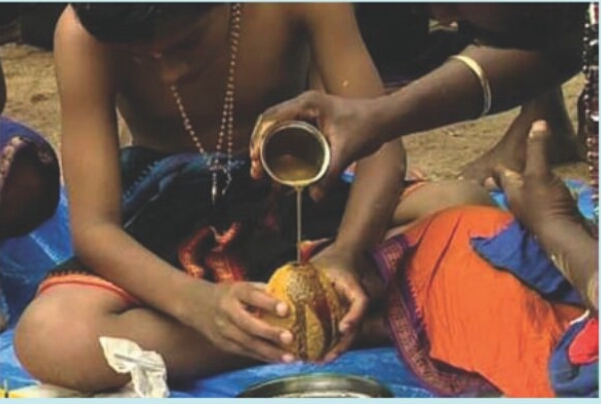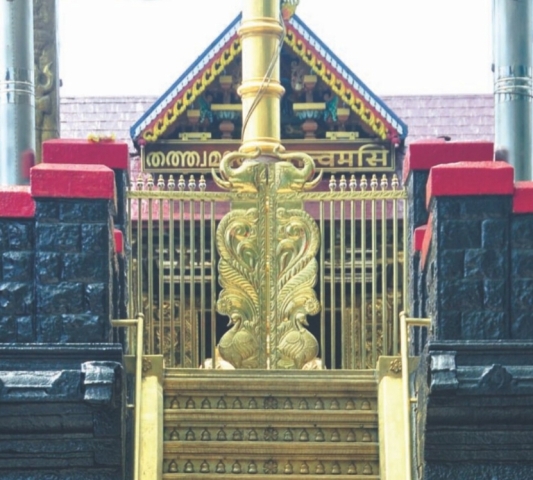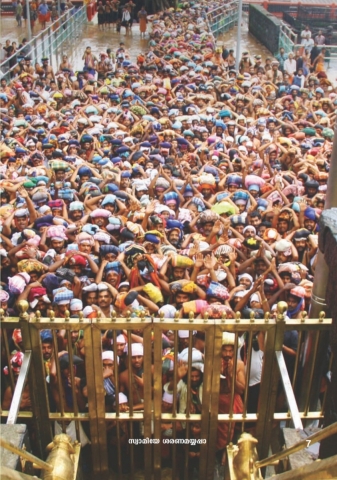Sabarimala Temple in the ‘Secular’ World

The holy hill of Sabari, Sabarimala, is located amidst the dense jungles of the Western Ghats in Kerala, bordering the state of Tamil Nadu. Vrischikam, the fourth month of the Malayalam calendar (November -December) marks the beginning of the annual pilgrimage to the temple. This is also when devotees observe ‘mandala vratham’ – 41 days of strict penance to cleanse oneself ahead of the trek to the shrine, through the dangerous jungle path. Such is the devotion that not only pilgrims, but even the faithful who cannot go to the shrine due to reasons like ill health also observe the ‘vratham’. The popularity of the shrine is an eyesore for the “breaking India forces” and attempts to destroy it have been on since long
The Ayyappa concept
It is not easy to decipher the ‘Devata sa~Nkalpa’( concept of divine deities) of Hinduism. Most of the deities are represented using complex cryptic epithets (paroksha priyaahi iva devah). In Kerala, Dharma shAstA (teacher of Dharma) is worshiped mainly in four places – Kulathupuzha, Aryankavu, Achankovil, and Sabarimala. While in Kulathupuzha, he is in the form of a `balaka’ (child), he takes the form of a ‘Grihasthi’ (home maker) with wives in Achankovil, and as an old `tApasa’ (ascetic) in Aryankavu. Whereas in Sabarimala, Ayyappa is in the form of a `kumara’ (teenager) observing brahmacharya (literally means pursuit of brahma but in modern times, is interpreted as celibacy). These four pratishtas (installations) denote the four stages of human life – childhood, teenage, family man and old age.
Ayyappa pratiShTha in Sabarimala sits in Arddhasana or Yogapadasana. This posture reveals the mood of asceticism, the tapobhAvaM. The knees are bound by `yogapatta’ (a belt made of cloth) and hands are in yoga mudra. Lord Ayyappa is a Brahmachari and an ascetic, his murti (idol) is made in sitting posture with the legs bent with his knees pointing upwards. Symbolically, this shows that the figure leaves no space for anyone to sit on its lap. Ayyappan in this state elevates one to the conscious awareness (observing) state which is called Sat-Chit-Ananda or meditative state.
With his Chinmudra, gesture of the hand, Ayyappa expounds the meaning of the supreme philosophy `Tat Tvam Asi’ (that art thou – you are that). The vrataM (austerities) is the basis for devotion. Since the deity is in the form of a naiShTika brahmachAri (absolute brahmachari), it is therefore believed to be the duty of every devotee who observes the pilgrimage to follow the vrataM with utmost sincerity and purity like a student who devotes his complete attention to the pursuit of knowledge. Once the believer starts the `Vratham’, he purifies his mind and body to become Ayyappa himself. So much so that he is called a swami thereafter. That’s the whole idea behind the hard and strict observance. Every devotee becomes a ‘Swami/God’ himself and acts as the Supreme Being would. They do this till they remove the rosary (which they don at the beginning of the vratham) from their neck upon return from the temple. The pilgrimage and associated rituals amply illustrate the sanatana dharma concepts of union of jIvAtmA (individual soul) with paramAtmA (supreme soul). This is also the underlying principle of ‘Advaita’, which says the two are not different, but one.
 When foreigners, ignorant of the traditions and shAstras, tried to decipher and translate the complexities of India’s systems and customs through a Semitic prism, we lost the sense behind most of the rituals and customs. The secular western education we subsequently acquired somehow made us unable to understand these cryptic epithets (parokSha sa~Nkalpa).
When foreigners, ignorant of the traditions and shAstras, tried to decipher and translate the complexities of India’s systems and customs through a Semitic prism, we lost the sense behind most of the rituals and customs. The secular western education we subsequently acquired somehow made us unable to understand these cryptic epithets (parokSha sa~Nkalpa).
‘Secular’ attacks against Sabarimala
The hugely popular Sabarimala temple has always been the target of interests inimical to Sanatana Dharma. Attacks on the shrine are as old as the ‘secular state’. One such major incident was the fire in the temple on 16th June 1950. The sanctum sanctorum was completely gutted and the deity was broken. An inquiry report by the Special Branch (CID) reportedly concluded that the fire was deliberate and hinted at a Christian angle to the crime. But what was the truth will never be known as governments have till this date shied away from making it public. In fact, the Communist party once even fought the polls on the promise of making it public, but went back on its promise after winning the elections.
The second `attack’ was more recent and came in the form of attempts to construct a church in front of the Mahadeva temple at Nilakkal (on the way to the temple), in the area regarded as Poonkavanam (Garden) of Ayyappa. As is commonly followed by church planters, a Cross was found near the Nilakkal temple on March 24, 1983. Media carried news of the ‘discovery’ of the church claiming it was planted by none other than Jesus Christs’ disciple St Thomas. Christian pilgrims started flowing to the spot. Soon, the road to the temple was named St Thomas Road and the Christians started calling the Nilakkal hill as St Thomas Mount. On May 19, within a month of the discovery, Kerala government approved a grant of 1 hectare of land to build Church in Nilakkal. This was fiercely opposed by Hindu organizations and thousands of believers, who took to protests, were arrested. But the relentless struggle of the Hindus ensured that Church planters had to shift the cross to a new location.
If this was not enough, there are still attempts being made by a section of Leftist historians to portray Ayyappa, who according to Hindu beliefs was the son of Lord Siva and Mohini (Lord Vishnu in female form) as a Buddhist.
The failed attempt to ‘make a church in Nilakkal, is off late being sought to be set off by linking Ayyapa’s story to another Church – Arthungal Church – in Alappuzha district. A rumour has been spread that the Ayyappa devotees after visiting Sabarimala must go to Arthunkal church where they should remove their ‘vratamAla’ (the beaded rosary worn during the vrataM). Some media houses actively serve this distortion. This fake story has `helped’ mislead many pilgrims coming from outside Kerala. False stories about Ayyappa killing a Christian saint St Sebastian (who according to Christian belief, he was killed during the Roman emperor Diocletian’s persecution of Christians) are also doing the rounds, with the active backing of vested interests. There is also the targeted propaganda portraying Ayyappa as a misogynist. The ‘secular’ attack on Sabarimala has been a coordinated activity, and is given a tweak from time to time.
Sabarimala and Women
A major charge levelled by some people against the temple is that Ayyappa is a misogynist. They link their allegation to restrictions placed on the entry of women in the 10-50 age group to the temple. They advertise this as a case of bias against women in general conveniently hiding the fact that girls below the age of 10 and women above the age of 50 are allowed entry to the temple. Their attempt is to present Hinduism as a regressive philosophy.

Yes, there are regulations regarding entry for young women of 10–50 age groups in Sabarimala. A tale substantiating this practice is the promise of Ayyapa to Malikapurathamma, the goddess of the nearby shrine. The destiny of Ayyapa’s birth was to kill the demoness Mahishi. Once he had killed the demoness, a beautiful woman emerged from the body. She requested Ayyapa to marry her. But since Ayyappa’s ambition was to practice brahmacharya and care for his devotees, he said no to the request. However, careful not to break her heart, he promised her that he will remain a Brahmachari till `kanni’ swamis (first-time devotees) stop coming to Sabarimala. But that is yet to happen as thousands of first time devotees climb the hill every year and Malikapurathamma still waits patiently with a heart full of love for the day she can marry Ayyappa. And mind you, her shrine is right beside that of Ayyappa on the Holy hill and the pilgrims to Sabarimala pay their respects to both deities.
As a matter of fact, the controversy surrounding the restrictions in Sabarimala to women in their reproductive age group seem to stem from an ignorance of the principles and practices of sanatana dharma, which is the forerunner of Hinduism) than any inherent problem with the religion (the Supreme Court calls it a way of life) itself. Sanatana Dharma is so complex and diverse that a mere cursory reading will not be sufficient to comprehend it. Such is the diversity of Hinduism that if there are restrictions on women in Sabarimala, there are restrictions on men in the Attukal temple in Thiruvananthapuram, there are temples where transgenders are accorded divine status as in Kottankulangara and also shrines where the menstrual phase of a woman is celebrated as in the Mahadeva temple in Chengannur. How can a “way of life’’ where the three main portfolios of finance, education and defense are handled by women – Lakshmi, Saraswati and Durga respectively – be anti-women?
But unfortunately, because of decades of physical and cultural invasion we have lost the precious knowledge necessary to interpret the wealth of information that was passed on to us by our forefathers. The Indic outlook has been replaced by the Semitic thinking infused through years of cultural annihilation carried out by the invaders.
If Lord Ayyappa was a misogynist, we would not have seen MalikaPurAth amma’s shrine near his abode. Women would not have visited Sabarimala temple before and after reproductive age. According to Hindu beliefs, Ayyappa is a brahmachari and stamping misogyny on brahmacharya is a Semitic tendency. Sanatana Dharma offers space for both men and women to practise brahmacharya. If brahmacharya by a man is interpreted as hatred for women, does that mean brahmacharya by a woman is hatred for men?
Faith and menstruation
A ludicrous theory being floated by ‘feminists’ about Sabarimala is that restrictions on the entry of women in their reproductive phase to the temple is because they become “impure’’ during their menstruating phase. It’s an outright lie. I have to say that such misconceptions stem from a lack of proper understanding of the evolution and process of dharma. Before explaining why, let us take a peek into what menstruation itself is.
Menstruation is just one of the special physical features bestowed on women by nature to make their body compatible for pregnancy and motherhood. It is the physiological process in which the body discards unfertilized ovum with the tissues of the endometrial lining of the uterus. The menstrual blood is not pure blood and has traces of dead tissue and vaginal discharges too. Most women experience disabling symptoms such as a headache, lower abdominal cramps, and dysmenorrhea when they have periods. The body turns tender and a majority of them feel weak and lethargic due to blood loss during this period and avoid strenuous physical activities and observe dietary restrictions. A study of societies across the globe would show that all of them have in one form or the other, kept women away from strenuous physical labor during this delicate phase. The logic behind this practice was not `impurity’ as the feminists would want us to believe, but the care for the physiological changes in the women’s body during the time. But many ignorant people interpreting the age-old wisdom has ensured that its positives are buried making it a tool in the hands of those who want man and woman to be in a state of perpetual conflict.
For a detailed discussion on menstruation and related practices in the Hindu community, do read the following:
Menarche (first menstruation) of girls is a big celebration for Hindus who also worship the blood stained cloth of the goddess of Chengannur Mahadeva temple. The menstrual periods of Sri Kamakhya Devi is worshipped in the Ambubachi festival of the Kamakhya temple. What does this tell us about the Hindu view on menstruation and the feminine?
Haindava sampradAya (system) isn’t one of prohibition or bans. Neither is it dogmatic. The mode of observance change from place to place and from deity to deity. The faithful understand and follow this voluntarily. This explains why in the past, the 41 day vrataM was compulsorily adhered to before the pilgrimage to Sabarimala. The vrathaM involved a rigorous routine like waking up in the wee hours and visiting temples after bath, eating frugally, (write here what else is done as part of vrathaM). For a woman, her monthly periods follow a 28-day cycle. As already discussed, the period requires utmost care and rest which would not be possible for a devotee on 41-day vrathaM. Besides, the trek uphill involved steep climbs though a dangerous forest which forms the core of what is now the Periyar Tiger Reserve infested with wild animals. Just imagine a woman having to trek miles and miles through the dense jungles in an era when they did not even have a sanitary napkin to depend on!
The journey uphill and the 41 days vrataM represents vAnaprasthaM which is also the last phase of a man/woman’s earthly existence. It comes after `gArhastyaM’ which means household life. So Vanaprasham should be performed after household life or gArhasthyaM. The fertility of a woman represents her dharma as a householder and the ability to create life. Accordingly women are advised to fulfill their grihastha dharma after which they can perform vAnaprasthaM. This is where Feminists brought up in western milieus go wrong with their interpretation. For them the very call to a woman to perform her garhasthya dharma is something unnatural and imposed by the patriarchal society which wants to bind her down in the name of duties. But what they fail to understand is the difference between duty and dharma. Duty is a manmade construct unlike dharma which is more fundamental and has more to do with man’s existence as an animal, for the collective upkeep of a larger ecosystem from where he/she draws certain things and returns some.
Sabarimala and the state
After the fire attack of 1950, Sabarimala temple and its rituals underwent significant changes and restructuring. More changes were introduced after the dhvajastaMbha (flag mast) was installed in 1969. These changes were intended to protect the sanctity of the temple. Legal sanctity for the restrictions to entry of women of particular age came after the Kerala Hindu Public of Public Worship (Authority of Entry) Rules, 1965 enacted by the ‘secular state’.

Initially though the temple was open only during the pilgrimage season (maNDalakAlaM) every year, better transport facilities and rush of pilgrims forced authorities to keep it open for a few days in the 1st week of the Malayalam months for `masapooja’ (monthly Pooja). Though women were allowed for the masapooja and annaprAsha (what is English for annaprasha), rarely would any women do that. Later, a High Court verdict totally banned darshan of women between the age group of 10 and 50. So if anything, it was actually the laws framed by the so called progressive secular forces which made even legitimate entry impossible.
Why Sabarimala?

From time immemorial, Sabarimala has been a devasthAna (abode of god) which attracts all devotees from every realms of humanity irrespective of caste and creed. Caste divisions accentuated by the colonial systems have been the bane of Hindu society. Many proselytizing forces trying to convert Hindus have exploited these differences to the fullest in the past and continue to do so. The Ayyappa of Sabarimala is a much revered figure not only in Kerala, but also in Tamil Nadu and Andhra Pradesh. Discrediting the deity is the best way to ensure that it loses appeal among the masses. The controversies surrounding Sabarimala are intended to achieve this nefarious objective.
Let me draw your attention to an extract from the K Keshava Menon Report on the 1950 Sabarimala Temple Arson case 1950. The report copies of which are floating in the cyberworld, confirms the worst fears about Sabarimala.
“It is reasonable to consider, Christians have got more familiarity and knowledge than Hindus in this direction, as they and they alone occupy the places and the base of this hills and they are the only persons who hunt and poach in the vicinity of the temple day in and day out. “
“… The desire for a church near the Sabarimala orthodox route seems to have been deeply rooted on their mind as otherwise there was no necessity for all these muthalalies (barons) to join on this business….. Thus, it can be seen that since some time, they have begun to feel the increasing number of lower caste Hindus visiting the Sabarimala temple in ecstasy and devotion, which in all probability they would have thought if not checked would inevitably result in a check to the growing process of conversion of low-caste Hindus to Christianity. Further, the existence of a church at Nilakkal and Pampakadavu would, in the long run attract Christians to colonise the area and thereby they could exploit these fertile regions and improve their financial conditions. “
Interestingly, the fire in Sabarimala as well as the formation of Hindu maha Mandalam to unite all castes of the Hindu community was in 1950.
Last but not the least
It will not be wrong to assume that the controversies that crop up during the Sabarimala pilgrim season reflect the secular contempt and intolerance for anything Hindu. The brainwashed lot want to impose Eurocentric monotheism on a population as divergent as the Hindus who see God in all beings, which taught the world that whichever faith you follow, you reach the same goal. This is what they did to the Greeks and all those people whom they sardonically refer to us pagans. For the Hindu, this has created a do or die situation. It’s time to stand up and be counted. It’s time to tell them – yes we are pagans, and we are proud of our diversity.
The Honorable Supreme Court of India defined Hinduism as a way of life. That leads us to the question how a way of life be governed by any single rule? Will that not kill the diversity and reduce the way of life to a mere ritual?
The article was originally posted in https://www.myind.net/
Welcome to Haindava Keralam! Register for Free or Login as a privileged HK member to enjoy auto-approval of your comments and to receive periodic updates.
Latest Articles from Dharma Smriti
- In memory of Dr N Gopalakrishnan
- Treading the Middle-Path on Temple Management
- ആദി ശങ്കര ജയന്തി – പ്രഭാഷണം
- അമേരിക്കന് പ്രൊഫസര് ജോണ് ഗ്രൈംസിന് ഭഗവാന് ഗണേശന് കൊടുത്ത ദിവ്യാനുഭവം
- Forgotten Temples Of Malappuram – Part I (Nalambalam of Ramapuram)
- Holy Karkidakam – Ramayana to Echo from Haindava Homes
- Poonthanam’s complete works translated into English
- Pamba Aarati – Dispell the Engulfing Darkness
- Milords! What the judiciary must know before any final verdict on Sabarimala
- Swami Chidanandapuri on Sabarimala


Responses